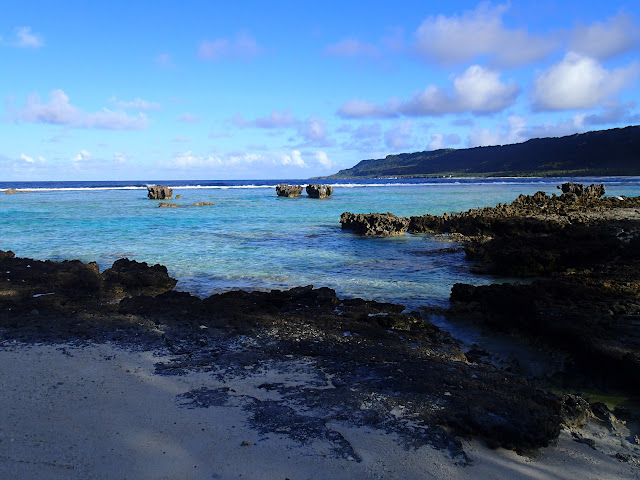We watched the butterflies and I was able to get a very nice photo of one of the Blue-banded King Crow, with his wings open wide. Along this path they were feeding on the flowers of a vine-like plant.


I saw one Golf Friterary, but it paused long enough for me to get a photo of the inside and the outside of its wings. Both are beautiful!

We saw butterflies that were black that reminded us of some kind of Swallowtail. In fact it is related to the Tiger Swallowtail. It is called the Common Mormon (Papilio polytes). I noticed that the forewings move very fast and independently from the hind wings which barely moved showing only the lower half of the butterfly in a photograph.

An image of the whole butterfly can be found online in the Butterflies of Micronesia, 7a, on plate 2, page 14.
http://guaminsects.myspecies.info/sites/guaminsects.myspecies.info/files/ButterfliesOfMicronesia.pdf

We started noticing spiders along the edge of the jungle. There were the large Hawaiian Garden Spiders that we see at our house at AWR. They make a large orb style web, and when I say large, I mean very large, maybe 2 feet across with guy lines stretching even further. The guy lines are strong too. I noticed that I could run into them and they wouldn't necessarily break.
Then I noticed that there were spider made structures that were more like a high rise apartment buildings, maybe 2 feet across and 3 - 5 feet height, with a on large spider on duty somewhere in the middle, but colored differently than the yellow Garden Spider.
It looked like there would be no chance for a butterfly who flew in. But then I discovered that Common Mormon butterflies are either very smart or have better eyesight than the spiders expected. I saw one fly in, pause for a minute, appear to get caught, and then turn and fly out of the spider trap. I wonder if it realized the great danger it was in.
I had seen some Blue-banded King Crow butterfly wings caught in other webs. The body was gone, and only one wing remained.

I think we saw three different colorings of these giant spiders, most of which were around 3 inches across.

We found some jungle plants that look like a cross between a tree and a fern. Looking them up, I learned they are called a Micronesian Cycad (Cycas micronesia). I saw something similar when I lived on Pohnpei. When I saw them I felt like I was really on a tropical island.
Online, I learned it used to be very abundant in Guam, but now is greatly threatened due to several factors. There is a scale that attacks it, the longhorn beetle causes stem damage, an invasive snail eats young leaflets, and humans destroy its habitat. A count in 2007 found only 87 Micronesian Cycads left on the island, down from 886 individual plants in 2004.
Our walk left the powerlines when they made a right hand turn and headed up the mountain and a jeep path continued to the left toward the ocean.
Once we were out at Scout's beach we saw a beautiful cove stretching around the the right and toward a limestone point. My foot had been cramping so I walked out into the water to see if the coolness would soothe it. The wavelets were just hitting the top of my foot, so I went in a little deeper and enjoyed the water. I wasn't paying attention to the waves and a bigger one snuck up and went almost to my knees followed quickly by one almost to my hips. I wasn't planning on getting wet, but I certainly was now. Oh well, it quite nice and cooled me off. You aren't supposed to get into the water in this area because there are a lot of clashing currents and many people have been pulled out to sea here, so though I was quite tempted, I didn't go splashing into the water for a swim.
We started walking to the left, toward camp. The cramps had subsided in my foot. There was cool shade on the high edge of the sand to keep us out of the equitorial sun. Limestone rock formations make pillars and tables for the water to rush around. Pools reflected aqua and torquoise blue. The reef here is made of limestone too, and not coral. Waves that crash on the reef often have the same blue. I really wished I could see what was in the water in this area, but I am limited to the sea creatures that wash up on the beach.

The sand is mostly white, but is also part orangish tan. The tan particles are star sand. They are the shell of a single celled organism that lives in the ocean and estuaries called foraminifera. You can find star sand on Guam and also in Japan. Forams, for short, also come in other shapes. Here is a page that tells you more.
https://www.burkemuseum.org/collections-and-research/geology-and-paleontology/invertebrate-and-micropaleontology/puget-sound-0
About this time my camera ran out of battery power, so I didn't get to photograph the rest of our walk. So I decided to come back tomorrow and see what else I could find.







Comments
Post a Comment